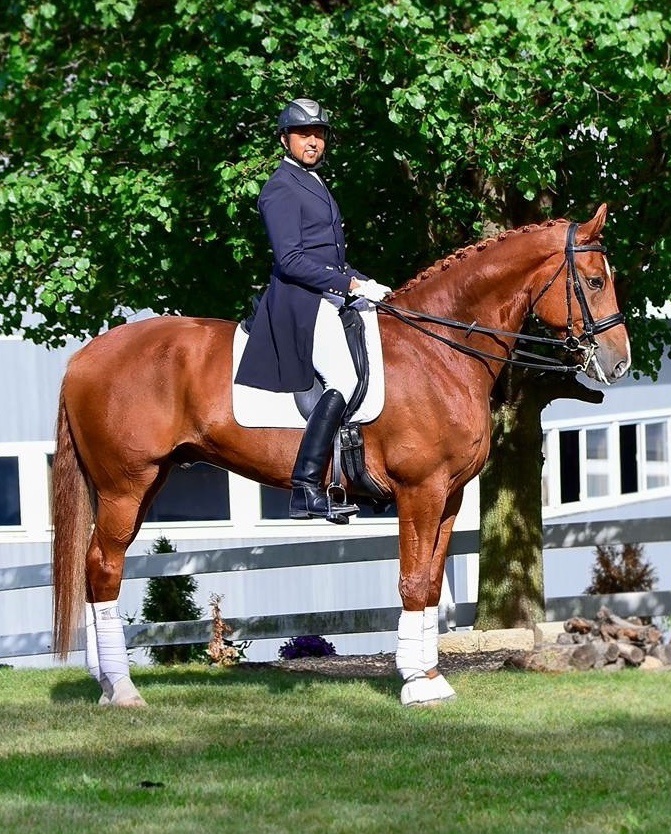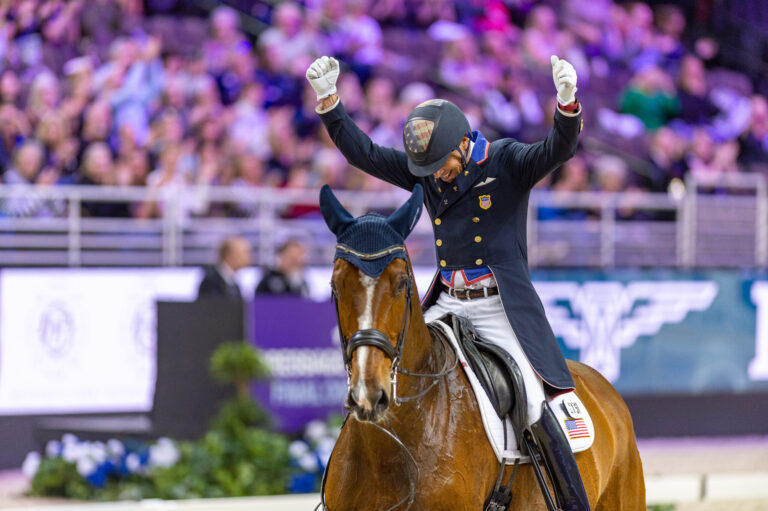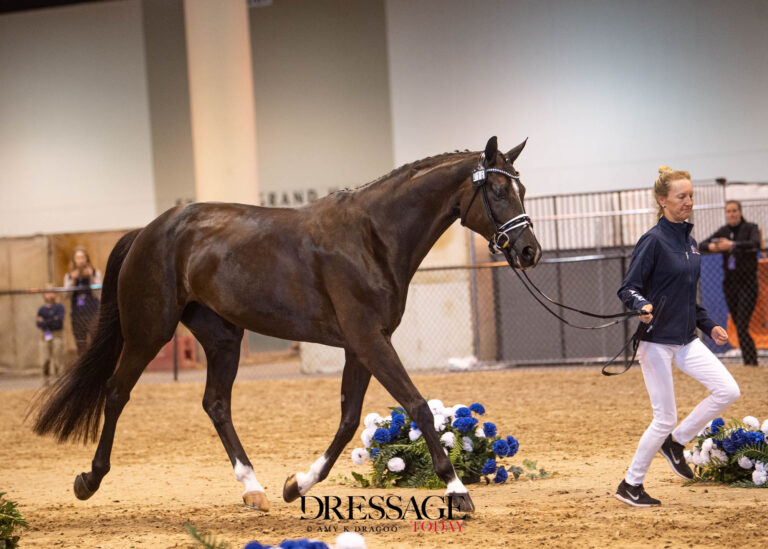Instead of just gazing wistfully at all the stallion ads this year, you’ve decided to breed your mare. Aside from all the breeding details, an important but sometimes overlooked item to think about is the registration of your future foal. Registration papers issued by an organized breed society are documentation of the breeder and owner of a horse, as well as proof of the horse’s age and pedigree. Putting off thinking about registration until your foal is born is easy to do. For a domestic purebred such as a Thoroughbred, Morgan or Quarter Horse, this may not be a problem. The usual requirement in this case is that both parents are registered with the breed organization and the appropriate paperwork and fees are filed.
Unlike domestic breeds, registering a foal in a warmblood registry can seem like a maze of rules and regulations. Because of this complexity, the ideal time to plan for registration is before the mare is bred. It is far safer to resolve potential registration issues before breeding than to wait until the foal is born and then discover that there is no way to get registration papers.
Why is registration so different for warmbloods? The difference comes from the fact that warmbloods, in general, are not pure breeds–in fact, most are open registries of horses that meet certain requirements. Historically these registries have been geographically based, i.e. in Hanover, they breed Hanoverians; in Westphalia, they breed Westphalians; and in Sweden, they breed Swedish Warmbloods. Horses are accepted into a registry if they meet the conformation, type, movement and bloodline requirements of the organization. The exception to this is the Trakehner, which is close to a pure breed; the only outside horses accepted into the studbook are Thoroughbreds, Arabs and Anglo-Arabs. Each registry has its own rules that cover which horses are eligible.
Registering a warmblood may seem confusing at first glance, but for the most part, it boils down to one very simple rule: both the mare and stallion must be approved for breeding by the same registry. By considering information on registration possibilities ahead of time, you can select the registry and approval options that will work best for your individual situation.
The Pros and Cons of Registration
A horse with registration papers is more valuable than one without. Not only are they essential for a breeding stallion, a registered filly has the potential to become a broodmare down the road, even if you plan only to ride her, it’s always a good idea to keep your options open. Geldings also are worth more when papered because registered horses can compete for prestige and monetary awards. Some award programs target dressage horses of many breeds, such as the U.S. Dressage Federation (USDF) All-Breeds Awards. These and other year-end breed-specific awards are becoming increasingly popular. New events are being developed to promote breeding in general, such as a proposed national young horse championship in the United States, modeled after the World Breeding Federation of Sport Horses Championships held yearly in Europe, where young horses are judged in-hand and under saddle. Also, the concept of U.S. Breeders Awards for all disciplines is being discussed. All of these awards and competitions will be open only to horses registered with their respective breed organizations.
Beyond the individual benefits, registering your foal will help improve sporthorse breeding in America by allowing the tracking of performance results by bloodline, as is done in Europe. “Even for the amateur rider, tracking the pedigree and performance of each horse is important.” says Mary Giddens, DVM, of the Dutch Warmblood Studbook in North America (NA/WPN). “It is impossible to reproduce the good horses or to produce better horses unless we know where they come from. We desperately need to tie performance data to pedigree in this country so that we can identify the stallions, and mares, that produce horses we want for the various disciplines.” Tracking the top performing bloodlines requires horses to be registered.
What’s the down side of registration? There’s the paperwork and, depending on the choices you make, the chore of hauling your mare and foal to an inspection site. The main drawback is usually the cost, which can be a few hundred dollars. However, the cost of registration is more than likely offset by the increase in value of the horse.
If you tend to put off things until a later date, keep in mind that registration sometimes has a limited time window. In many cases, only horses two years old and under are eligible to be registered, with higher fees required after the year of birth. Should you decide that you really want to register your 4-year-old to be eligible for All Breeds Awards, you may be out of luck.
Mare Requirements
To determine the registration possibilities for your foal, begin with your mare. The first requirement of most breed organizations is that the mare be registered with a breed registry that provides a documented pedigree back three or four generations. Some registries also have a minimum height requirement.
Next, the bloodlines found in her pedigree must be acceptable to the organization. Those found acceptable usually are Thoroughbred, Arab or domestically bred or imported warmbloods. Some registries, such as the American Hanoverian Society, strictly limit the bloodlines and outside registries they accept. Others, such as the Oldenburg and Swedish Warmblood organizations, are more inclusive.
If you have a specific stallion or registry that interests you, check the rules of that registry to see if your mare is eligible. If you haven’t already chosen a particular registry, check with several to see what the options are for your mare.
Mares from non-traditional sporthorse bloodlines, such as Morgan or Quarter Horse may not qualify for a traditional warmblood registry studbook. As a result, their foals may be eligible only for a certificate of pedigree from these registries. The same is true if you plan to cross a stallion from one of these domestic breeds with a warmblood mare. While not recognized as registration papers, a certificate of pedigree at least documents the bloodlines of the foal. However, many domestic breed associations have auxiliary registries, such as the appendix Quarter Horse registry, which provides part-bred papers for such crosses. There are also several American registries that paper Thoroughbred or other crosses with warmbloods, such as the Performance Horse Registry (PHR).
If your mare’s bloodlines are acceptable, the next step is getting your mare approved. Most German registries require the mare to be physically inspected at one of their yearly inspection sites. This will involve showing your mare in hand so her conformation and gaits can be evaluated. Some organizations, such as the Swedish Warmblood Association of North America (SWANA) will accept your foal by an approved Swedish stallion for registration based on the mare’s pedigree alone, although inspection is also available for those wanting expert evaluation and for the feedback on your breeding program. In some cases a combination of pedigree and/or inspection determines the registration choices. Many organizations have several registry “books” at different levels depending on the qualifications of the mare. For instance, the NA/WPN has a whole matrix of registration possibilities depending on the status of your mare and the stallion. The good news is that all of this information is readily available from the breed registries themselves, sometimes on their Web sites. If the registry that interests you requires your mare to be physically inspected, the location of the inspection sites is an important point. Registries usually can provide a list of sites for the current year, so you can find one that’s convenient. Whether the inspection site is next door or two states away can make or break your breeding decision. If your mare must be inspected, it is usually best to present her the year before she foals or even before she is bred. The reasons for this are three-fold. First, the mare usually will be less distracted when not worrying about the foal, and she will present herself better, resulting in a higher score. Second, once the mare has been presented, you know exactly where you stand as far as registration possibilities. And third, the inspection also will give you important feedback on what the inspectors see as your mare’s strong and weak points–information that can be helpful in selecting a stallion.The Stallion–Registered, Licensed, Approved
When selecting a stallion for your mare, keep in mind that almost all warmblood registries require a stallion to be approved or licensed by their specific organization in order to register his foals. Being licensed and/or approved is different from being registered. A registered stallion is simply one that received papers and possibly a brand as a foal, no different from any other foal. In general, a licensed stallion has gone through physical inspection or kuering–in hand and free jumping–as a young adult. Based on his being accepted by the breed organization, the stallion is “licensed” to breed. He is usually required to complete some sort of competition test or 100-day test, at which point he becomes fully “approved.” While the approval terminology may vary from registry to registry, the concept is the same. One of the only warmblood organizations to allow registration possibilities for the offspring of unlicensed stallions is the NA/WPN, but only on a very limited basis. When looking through the pages of eye-catching stallion advertisements, be aware that just because a brand is displayed prominently does not mean that a stallion is approved by that breed society. Unless the ad specifically says the stallion is licensed or approved by the registry, the display of a brand may only mean that the horse is registered with that registry. To make things even more confusing, some stallions are registered with one association, but approved for breeding with a different association. Even with an approved stallion, the offspring may not be registerable unless his owner has paid the organization’s stallion fee for the year. The only way to be certain that a stallion’s foals can be registered is to check with the breed society in question. Almost all breed societies have a list of currently approved stallions available for the asking or posted on their Web site. Most publish an annual stallion book, which not only has a list of approved stallions, but information on the breeding policies and rules of the registry. These books are treasure troves of information and are usually available to nonmembers for a small fee. Stallions also can be approved and/or licensed by multiple breed registries. After selecting a stallion, you may find that your foal appears to be eligible for registration with multiple breed societies. However, tracking performance results requires that each horse must be uniquely identified; multiple registrations of the same horse confuse the issue. This is one of the reasons why the dual registration is not allowed under the rules of the World Breeding Federation of Sport Horses. The Federation of North American Sporthorse Registries (www.sporthorsefederation.org) agrees with this viewpoint and members will not knowingly issue a second set of papers for the same horse. Select one registry for your foal and proceed according to its rules.The Mechanics of Registration
The key to any registration process is the “breeding certificate”–documentation with the stallion owner’s signature that verifies the stallion did indeed breed or the farm shipped the stallion’s semen to the mare in question. Without a breeding certificate, you usually have no chance of registration. So once you receive the breeding certificate from the stallion owner, stash it in the family vault. The certificate itself varies from a standard registry form to a letter from the stallion owner. If the breeding was by shipped semen, some registries have a form to be signed by the veterinarian that did the insemination, others leave that part up to the stallion owner. Once the foal is on the ground, the next step depends on the registry and your mare’s approval status. If your mare is not yet approved, she needs to go through the approval process for your selected registry. If she’s already approved, then usually one of two things will need to happen. In one case, the mare, foal, the breeding certificate and the mare’s papers need to go to an inspection site for registration and branding. Otherwise, the registry will require you to mail to them a copy of the breeding certificate, photographs of the foal and a copy of the mare’s papers. Many registries also require blood or DNA typing of the mare and foal for parental verification–this proves the foal’s parents are indeed those listed on the breeding certificate. Information on acquiring a DNA-typing kit is usually provided by the breed society when you apply for registration. In some cases, the cost is included in the registration fee; in others, there is a separate fee. If you’re planning to take your foal to an inspection and parental verification is required, to starting the process early is important so that the blood or DNA typing can be completed before the inspection. It’s recommended that a foal be six to eight weeks old prior to blood typing. When the last of the paperwork is completed and any necessary inspections attended, your part of the job is finished. The rest of the paperwork is up to the registry. As most of the warmblood registries are heavily booked for inspection tours in the late summer and early fall, you usually will receive your papers either that fall or early next spring.Tracking Identity & Performance
Bloodline performance tracking could mean a future where interested mare owners could more easily choose a stallion based on the performance results of his offspring, not just the size of his advertising budget. All well and good, but if you’re breeding this year, how does future performance tracking affect you? There are programs under development that will bring more benefits to competitors and those who register their foals. According to Cheryll Frank, director of sport data for USA Equestrian (formerly AHSA), a uniform database for all show records from recognized shows is under development. The goal is for this database to be available to members via the internet by the end of 2002. In order to track sport performance, each horse must be uniquely identified, so that horses with the same name can have their results recorded correctly. At USA Equestrian, a Mandatory Horse ID Number rule change is in the works. If passed, it would require identification or life numbers for all horses at all levels of recognized competition. Three warmblood registries already receive USA Equestrian ID numbers for foals with their registration papers. With the advent of the mandatory life number and other possible changes in the works, remaining breed registries may soon follow suit. If this comes to pass, registering your foal would make later application for an ID number unnecessary. A registered horse would be competition ready at local and regional levels. Currently national competition (eligibility for Horse-of-the-Year awards, etc.) requires a horse to have Life Recording with USA Equestrian, while the F?d?ration Equestre Internationale (FEI) level competition requires an FEI passport. At a recent meeting of the Federation of North American Sport Horse Registries (www.sporthorsefederation.org), members asked USA Equestrian representatives to investigate the concept of issuing passports for foals. “As it has been proposed, such a program would issue a National Passport for each foal as part of the registration process,” says Frank. “This passport would serve as permanent identification for the horse and would be acceptable for use in national competitions and FEI competitions up to a certain level. The foal passport could be upgraded to an USA Equestrian Life Recording and would be acceptable for use in national competitions and FEI competitions up to a certain level. The passport could be further upgraded to an international FEI passport at any time. “Benefits to breeders from this program would be many,” says Frank. “First of all, it is proposed that the national passport would meet all requirements for any future mandatory horse ID rule change passed by USA Equestrian. In addition to its uses in national and FEI competition, the existence of such a passport would give breeders an unbroken chain of custody for their breeding products and the ability to track their performance in the future.”Kyle Karnosh owns and manages Con Brio Farms in Gilroy, California, with husband, Tim Carey. For the past 15 years they have bred Oldenburgs, Hanoverians and Dutch Warmbloods, producing premium foals and mares and successful dressage horses competing up to Intermediaire I.











